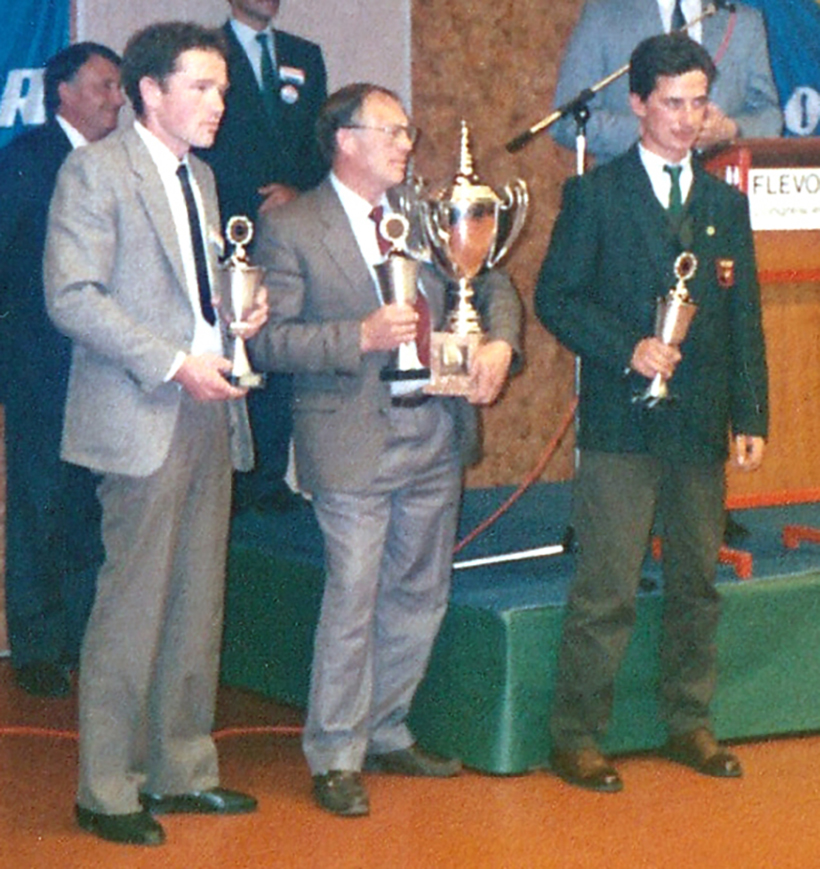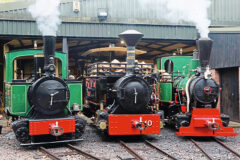The very collectable Ford Force 4000
Posted by Chris Graham on 9th November 2023
The Ford Force 4000 was a top-selling tractor in the late 1960s and survivors are now in big demand, as Bob Weir reports.

The 4000 was a popular tractor in Ford’s new 1000 range first introduced in 1964. The 1000 Series range was built in Basildon, Michigan and Antwerp, and put on sale worldwide.
The area around North Wales and Cheshire is a hive of activity. Farming is big business and agriculture provides jobs and a healthy environment to support a strong economy. Tractors have had a key role to play over the years, and there are still plenty of old classics hidden away in local barns.
Ian Wilson spent his childhood on various farms in the area and has lived on the same smallholding since he was a teenager. “The family originally lived on a rented farm near Chester, but my father was forced to move out in 1947,” he explained. “Things were difficult after the Second World War, but he managed to get work as a farm manager. We eventually moved to a five-acre smallholding, and have stayed here ever since. I’ve been driving tractors all my life and, even though I’m in my eighties, I still take part in ploughing matches.”

Although the new 1000 Series models were warmly appreciated by the farming press, the early pre-Force versions had to battle through some niggling problems.
An early start
Like a lot of boys of his generation, Ian started driving tractors when he was very young. “Before I learned to drive, I used to enjoy just sitting on the seat of our 1943 Fordson N, and playing with the steering wheel,” he recalls. “The ‘N’ was an important tractor in those days, and popular with farmers. When I first had a go at ploughing I was only seven years old, and struggled to press the clutch down! I liked driving tractors and that’s all I ever wanted to do.”
When Ian left school at 15, he went to work on a local farm. He remembers that, even at that young age, he was very keen on ploughing matches. “The farmer had just taken delivery of one of the new Fergie T20 diesels,” he said. “I took part in my first ploughing match when I was just 15. Ironically, I wasn’t old enough to drive, but I still took the tractor to the field and won the under-21 category.”
Of course, things were very different during the post-war years, compared with today. Many part-time farmers like Ian’s father also had a full-time job. Ian also recalls keeping a few pigs in the past but, nowadays, the land is given over to his granddaughter’s horses. “I was never keen on working with farm animals, although that was sometimes part of the job,” he recalls. “I much preferred ploughing and driving tractors. I’ve driven any number of different machines over the years, but have always had a liking for Ford and Fordson.”

The driving position and controls were class-leading by the standards of the day. Ian’s 4000 has just 2,869 recorded hours; not bad for a 50-year-old tractor!
Driving for a living
By the time he was in his early twenties, Ian was driving tractors for a living. “By that stage, National Service had ended,” he said. “Farm workers had been exempt, provided they worked on a farm for eight years. I then started working for a contracting firm, which specialised in looking after local sports grounds and school playing fields. It was mainly land drainage work and involved the use of various crawlers and tractors. After that I drove trucks for McAlpines, at the time the company was busy with the building of the M6 motorway.”
Ian drove lorries for a living until he heard about a job for a tractor demonstrator being advertised at a Massey Ferguson dealership in Chester. “Massey Ferguson was about to launch its 1000 Series range, and dealers were looking to promote the new tractors,” he said. “I knew how to handle a plough, which probably got me the job. Massey Ferguson then ran a series of demonstration ploughing matches. After coming third in a couple of the heats, I won another third place at the national final, which was held at the company’s academy in Stoneleigh, near Kenilworth.”
Ian got talking to a colleague at that event, who happened to mention a similar demonstrator job that was being advertised by Ford in Farmers Weekly. “I got hold of a copy of the paper and sent off an application,” he told me. “One thing led to another, and I ended up working for Ford.”

Although the 4000’s three-cylinder engine was considered reliable, the unit was dogged by porous block issues.
Ian had to attend an interview and recalls that it was a strange feeling visiting a city the size of London. “I was just a country boy and had never answered a telephone in my life,” he laughed. “After I passed the interview, I went to Ford’s training school at Boreham House, in Chelmsford. I spent the next few years visiting shows and Ford dealers demonstrating the new Pre-Force and Force tractors that were being built at Ford’s new plant in Basildon.”
Fond memories
Ian worked as part of Ford’s demonstration team from 1966 to 1982. He has fond memories of this period as he met plenty of interesting people, and the job took him all over the UK. “I then worked for Dowdeswell Engineering until I retired,” he explained. “Roger Dowdeswell was involved in making a linkage for mounting ploughs on the back of crawler tractors. This was also fascinating work.”
Ian also started competing in ploughing matches on a regular basis, and won the European (Reversible) title in 1990. “I’ve always enjoyed ploughing since I was a teenager,” he said. “The size of tractors has certainly changed over the years, but the principles of ploughing remain the same. You need to concentrate at all times and keep your wits about you.”

Ian Wilson is a Ford tractor man through-and-through.
Ian has also built up a small collection of tractors, including a Ford 3000. But pride of place among his machines currently goes to his Ford 4000. “I bought the tractor from an enthusiast in 2015,” he recalls. “It was in reasonable condition and didn’t require a great deal of work. I don’t know anything about the early history of the tractor, but it suits me just fine.”
The 4000 was an influential tractor in its day, and part of the company’s popular 1000 Series range. Ford had responded to calls for more power and a modern design when it introduced the ‘6X’, or Pre-Force machines, in 1964. This was a four-model line-up and tractors destined for the UK market came from the new factory in Basildon, Essex. The ‘Fordson’ brand was discontinued at the same time, although it was decided to keep using traditional names like ‘Dexta’ and ‘Major’, as they had a good reputation with farmers.
A new range
Ford also adopted a numbering system, and the models were marketed as the 2000 Dexta (37hp), the 3000 Super Dexta (46hp), the 4000 Major (55hp) and the range-topping 5000 Super Major (65hp). These tractors were sold worldwide as Ford was looking to promote a global brand in all its factories, to take advantage of economies of scale. The Super Major had a four-cylinder diesel engine, while the other three tractors used a three-cylinder motor. The new tractors went on Ford’s stand at the 1964 Smithfield Show, and the initial response was promising.

Ian at the Wiltshire ploughing marathon, in 1966.
The 6X machines were all well equipped by contemporary standards, including the optional Select-O-Speed, 10-speed, powershift transmission. Unfortunately, there were lots of teething problems with that system, as a result of which, Ford found itself swamped with warranty claims. The company managed to ride out the bad publicity, and tractors like the 4000 soon started proving their worth among working farmers.
Ford updated the four models in 1968, when it introduced the ‘6Y’, or Force range. Both the styling and performance were improved, and the 4000’s power was boosted to 62hp. Reliability and sales were impressive, and the 6Y range was topped-off in 1971 with the introduction of the 94hp 7000 model.
As time moved on and tractors got bigger, machines like the 4000 became a popular second-hand buy. A lot of the tractors were reduced to the role of yard scrapers and, these days, the condition of such machines depends on how they were serviced and maintained during their working lives. “My 4000 is an early Force model (serial number B851865), and was built in May 1968,” Ian said. “The tractor is in pretty much the same condition as when I bought it, although I have made a few repairs.

A forage demonstration in Wales, back in 1967.
“The previous owner had done a bit of work himself, including fitting a new pair of wings. But the paintwork was looking a bit tired, so I decided to respray the chassis and wheels. I also put larger wheels on the front to improve its road work.”
Looking authentic
Ian prefers his tractors to be as authentic as possible and so was pleased to find that his 4000 was still wearing some of its original parts. “The tinwork, like the bonnet and dash, are still the factory-fitted items,” he said. “I keep the tractor stored out of the weather, which also protects the paintwork.”

Taking part in an event in Norway, in 1971.
But Ian has also had to replace some parts, including lower links, double spool valves, and he’s added power steering. “The power steering came off another tractor,” he explained. “It certainly improves the tractor’s handling both on and off road. I currently use the 4000 as my ploughing tractor, with a homemade plough that I built using mainly Dowdeswell parts.”
Fortunately for Ian, the 4000’s engine has also stood the test of time. “The three-cylinder motor was a nice engine and both durable and reliable,” he said. “I think that this was one of the reasons why the tractor was so popular with farmers. There were a few problems with porous blocks, and some owners cut corners with maintenance and lubricants. But, if you service them on a regular basis, you will get years of trouble-free ownership.”

Ian (centre) receiving the European Championship Ploughing Match award in 1990.
Ian has done most of his own servicing and maintenance over the years, and still gets a lot of pleasure from working with his tractors. “Like a lot of lads of my generation, I got used to working with tools from a young age,” he said. “Garages always represented an expensive option, and you learned very quickly to mend and make do. I think one of the important things for keeping your tractors in tip-top condition is to take your time and to do things properly. Ford spare parts are still available, although they’re becoming expensive, like everything else.”
Although Ian is pushing on into his eighties now, he has no intention of slowing down in the near future. At the time of my visit, he’d just taken part in a ploughing match near Shrewsbury, which necessitated a 100-mile round trip. “Tractors have played a big part in my life, and have given me years of enjoyment,” he said. “Ford and Fordson machines have always been in my blood, and I certainly intend to hang on to my examples for the foreseeable future.”
This feature comes from a recent issue of Ford & Fordson Tractors, and you can get a money-saving subscription to this magazine simply by clicking HERE

Previous Post
1972 Massey Ferguson 625 combine harvester works again

Next Post
Bredgar & Wormshall Light Railway’s Gala Day



